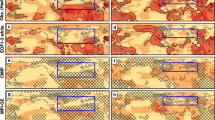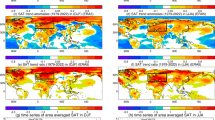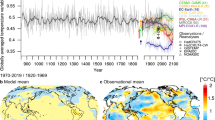Abstract
The range of possibilities for future climate evolution1,2,3 needs to be taken into account when planning climate change mitigation and adaptation strategies. This requires ensembles of multi-decadal simulations to assess both chaotic climate variability and model response uncertainty4,5,6,7,8,9. Statistical estimates of model response uncertainty, based on observations of recent climate change10,11,12,13, admit climate sensitivities—defined as the equilibrium response of global mean temperature to doubling levels of atmospheric carbon dioxide—substantially greater than 5 K. But such strong responses are not used in ranges for future climate change14 because they have not been seen in general circulation models. Here we present results from the ‘climateprediction.net’ experiment, the first multi-thousand-member grand ensemble of simulations using a general circulation model and thereby explicitly resolving regional details15,16,17,18,19,20,21. We find model versions as realistic as other state-of-the-art climate models but with climate sensitivities ranging from less than 2 K to more than 11 K. Models with such extreme sensitivities are critical for the study of the full range of possible responses of the climate system to rising greenhouse gas levels, and for assessing the risks associated with specific targets for stabilizing these levels.
This is a preview of subscription content, access via your institution
Access options
Subscribe to this journal
Receive 51 print issues and online access
$199.00 per year
only $3.90 per issue
Buy this article
- Purchase on SpringerLink
- Instant access to full article PDF
Prices may be subject to local taxes which are calculated during checkout



Similar content being viewed by others
References
Schneider, S. H. What is dangerous climate change? Nature 411, 17–19 (2001)
Reilly, J. et al. Uncertainty in climate change assessments. Science 293, 430–433 (2001)
Wigley, T. M. L. & Raper, S. L. Interpretation of high projections for global mean warming. Science 293, 451–454 (2001)
Allen, M. R. & Stainforth, D. A. Towards objective probabilistic climate forecasting. Nature 419, 228 (2002)
Allen, M. R. & Ingram, W. J. Constraints on future changes in climate and the hydrological cycle. Nature 419, 224–232 (2002)
Palmer, T. N. Predicting uncertainty in forecasts of weather and climate. Rep. Prog. Phys. 63, 71–116 (2000)
Smith, L. What might we learn from climate forecasts? Proc. Natl Acad. Sci. USA 99, 2487–2492 (2002)
Kennedy, M. C. & O'Hagan, A. Bayesian calibration of computer models. J. R. Stat. Soc. Ser. B Stat. Methodol. 63, 425–450 (2001)
Murphy, J. M. et al. Quantifying uncertainties in climate change from a large ensemble of general circulation model predictions. Nature 430, 768–772 (2004)
Knutti, R., Stocker, T. F., Joos, F. & Plattner, G. K. Constraints on radiative forcing and future climate change from observations and climate model ensembles. Nature 416, 719–723 (2002)
Forest, C. E. et al. Quantifying uncertainties in climate system properties with the use of recent climate observations. Science 295, 113–117 (2002)
Allen, M. R., Stott, P. A., Mitchell, J. F. B., Schnur, R. & Delworth, T. L. Quantifying the uncertainty in forecasts of anthropogenic climate change. Nature 417, 617–620 (2000)
Stott, P. A. & Kettleborough, J. A. Origins and estimates of uncertainty in predictions of twenty-first century temperature rise. Nature 416, 723–726 (2002)
Cubasch, U. et al. in Climate Change 2001, The Science of Climate Change (ed. Houghton, J. T.) Ch. 9 527–582 (Cambridge Univ. Press, Cambridge, 2001)
Allen, M. R. Do-it-yourself climate prediction. Nature 401, 627 (1999)
Stainforth, D. et al. Distributed computing for public-interest climate modeling research. Comput. Sci. Eng. 4, 82–89 (2002)
Hansen, J. A. et al. Casino-21: Climate simulation of the 21st century. World Res. Rev. 13, 187–189 (2001)
Stainforth, D. et al. Climateprediction.net: Design principles for public-resource modeling. In 14th IASTED Int. Conf. on Parallel And Distributed Computing And Systems (4–6 November 2002) 32–38 (ACTA Press, Calgary, 2002)
Stainforth, D. et al. in Environmental Online Communication (ed. Scharl, A.) Ch. 12 (Springer, London, 2004)
Giorgi, F. & Francisco, R. Evaluating uncertainties in the prediction of regional climate change. Geophys. Res. Lett. 27, 1295–1298 (2000)
Palmer, T. N. & Raisanen, J. Quantifying the risk of extreme seasonal precipitation events in a changing climate. Nature 415, 512–517 (2002)
Collins, M. & Allen, M. R. Assessing the relative roles of initial and boundary conditions in interannual to decadal climate predictability. J. Clim. 15, 3104–3109 (2002)
Pope, V. D., Gallani, M., Rowntree, P. R. & Stratton, R. A. The impact of new physical parameterisations in the Hadley Centre climate model – HadAM3. Clim. Dyn. 16, 123–146 (2000)
Gregory, J. M. et al. An observationally-based estimate of the climate sensitivity. J. Clim. 15, 3117–3121 (2002)
Andronova, N. G. & Schlesinger, M. E. Objective estimation of the probability density function for climate sensitivity. J. Geophys. Res. 106, 22605–22612 (2001)
Morgan, M. G. & Keith, D. W. Climate-change — subjective judgments by climate experts. Environ. Sci. Technol. 29, 468–476 (1995)
Smith, L. A. in Disentangling Uncertainty and Error: On the Predictability of Nonlinear Systems (ed. Mees, A. I.) Ch. 2 (Birkhauser, Boston, 2000)
Covey, C. et al. An overview of results from the coupled model intercomparison project. Glob. Planet. Change 37(1–2), 103–133 (2003)
McAveney, B. J. et al. in Climate Change 2001, The Science of Climate Change (ed. Houghton, J. T.) Ch. 8, 471–524 (Cambridge Univ. Press, Cambridge, 2001)
Williams, K. D., Senior, C. A. & Mitchell, J. F. B. Transient climate change in the Hadley centre models: the role of physical processes. J. Clim. 14, 2659–2674 (2001)
Acknowledgements
We thank all participants in the ‘climateprediction.net’ experiment and the many individuals who have given their time to make the project a reality and a success. This work was supported by the Natural Environment Research Council's COAPEC, e-Science and fellowship programmes, the UK Department of Trade and Industry, the UK Department of the Environment, Food and Rural Affairs, and the US National Oceanic and Atmospheric Administration. We also thank Tessella Support Services plc, Research Systems Inc., Numerical Algorithms Group Ltd, Risk Management Solutions Inc. and the CMIP II modelling groups.
Author information
Authors and Affiliations
Corresponding author
Ethics declarations
Competing interests
The authors declare that they have no competing financial interests.
Supplementary information
Supplementary Discussion
Discussion of the PC based model and how the control climates of different model versions compare with observations. Also, discussion of the mechanism which can lead to unphysical cooling in a model with a mixed layer ocean. Finally, some comments on the sensitivity of results to the choice of perturbations. (DOC 30 kb)
Supplementary Figure Legends
Legends for the supplementary figures. (DOC 24 kb)
Supplementary Figure 1
Comparison of annual mean temperature and precipitation fields with observations for: i) the super computer version of HadSM3, ii) the unperturbed climateprediction.net model version, iii) a low sensitivity model version, and iv) a high sensitivity model version. (PDF 444 kb)
Supplementary Figure 2
The difference in annual mean surface temperature between control and calibration phases for a stable and an unstable simulation; the latter exhibiting the cooling problem described in the supplementary discussion. (PDF 110 kb)
Supplementary Figure 3
Temperature and temperature anomaly fields from a simulation exhibiting the cooling problem in the double CO2 phase. (PDF 132 kb)
Supplementary Figure 4
Further exploration of the sensitivity of the simulated climate sensitivity distribution to the choice of parameter perturbations. (PDF 14 kb)
Rights and permissions
About this article
Cite this article
Stainforth, D., Aina, T., Christensen, C. et al. Uncertainty in predictions of the climate response to rising levels of greenhouse gases. Nature 433, 403–406 (2005). https://doi.org/10.1038/nature03301
Received:
Accepted:
Issue Date:
DOI: https://doi.org/10.1038/nature03301



